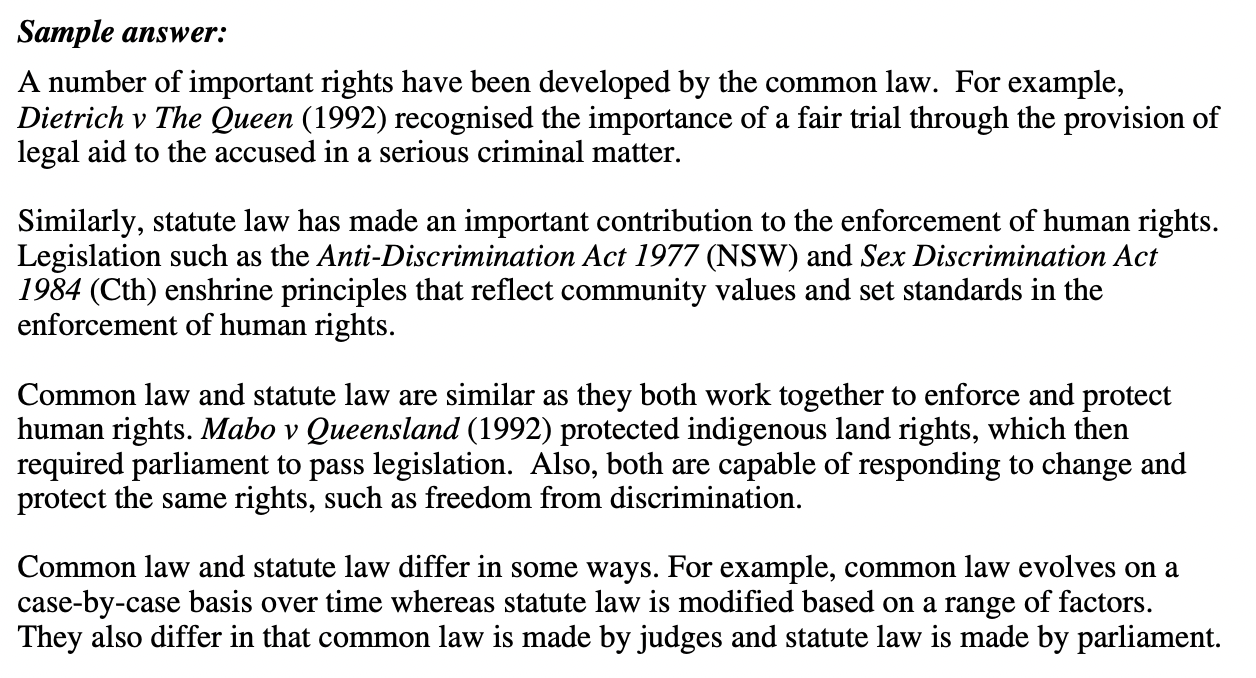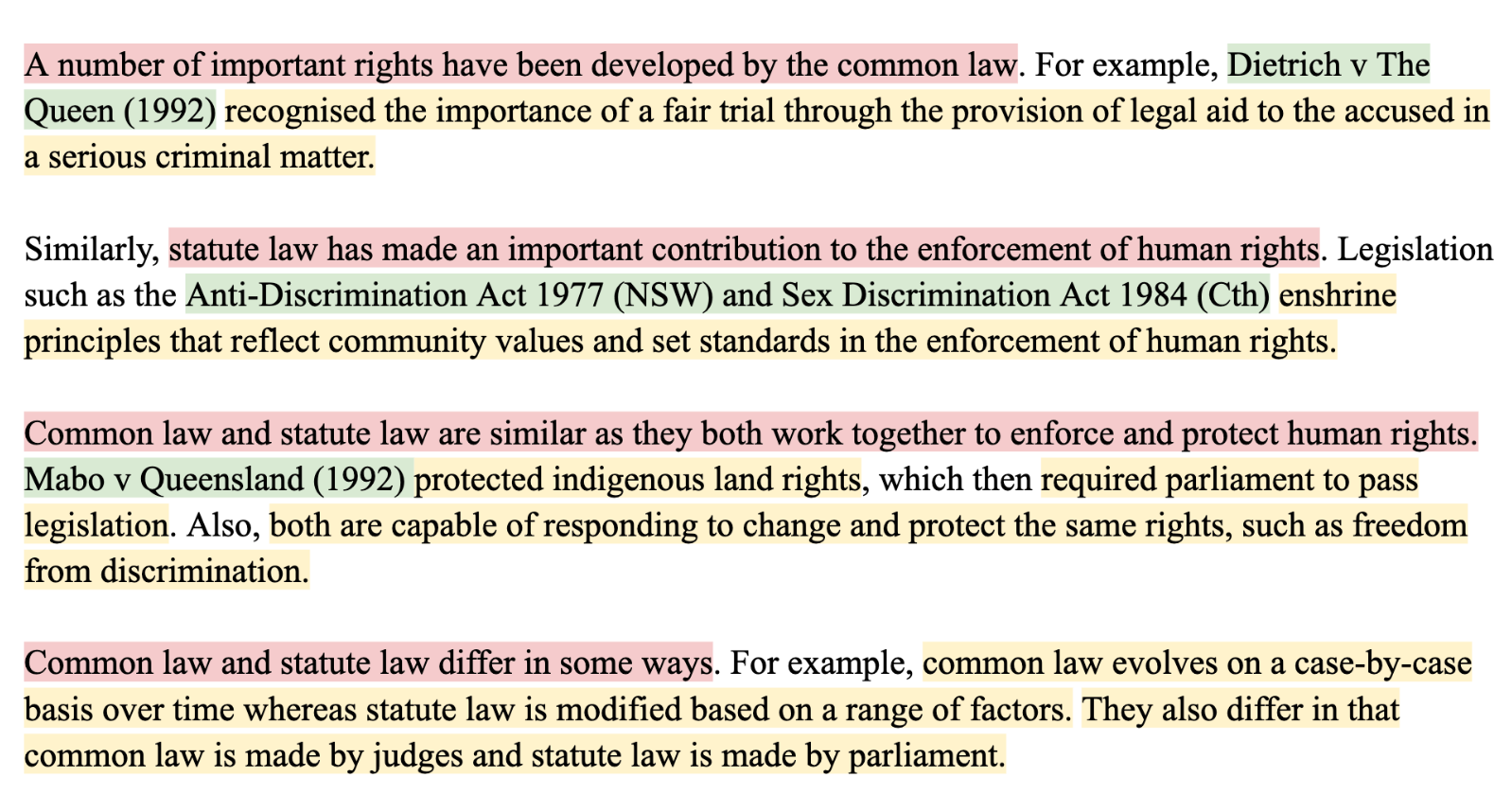Many students miss out on easy marks because they don’t answer the question properly and miss key bits of information. So here’s a simple guide to make sure you ace every question in your next legal studies exam.
First things first break down the question
This is arguably the most important step because it ensures that you aren't wasting precious time waffling about the wrong things.
The first thing to do here is to identify the task word, like describe, outline or evaluate. They will require you to do different things - it's all defined in the syllabus.
- Identify requires you to name or set out main features.
- Describe requires you to set out features or characteristics.
- Outline requires you to give a general account indicating key features or characteristics.
- Compare or contrast requires you to discuss similarities and differences.
- Explain requires you to make a detailed description of key features and characteristics.
- Examine requires you to explain and make a judgement while addressing the positives and negatives.
- Evaluate requires you to make judgments based on evidence.
Next, identify Key Words
Let's use an example from 2015's Legal Studies HSC paper

Here the keywords are
- Australian Human Rights Commission: Use them as an example (or another independent statutory authority) in your response.
- Promotes human rights: you need to link these processes to the promotion of human rights.
This basically will tell you the things you need to do to score full marks;
- Describe the processes used by the AHRC or another independent body.
- Provide a link to how these processes promote human rights.
It is common for students to over-write during short answers and not give themselves enough time for essays. The space provided is a general indication of how much the markers are expecting and you want to be as clear and concise as possible.

In this response, we have identified two methods of the AHRC; awareness programs and releasing reports, and linked them to the promotion of human rights, ticking off the two requirements of the question.
Let's do a harder example! Question 23 of 2015's HSC paper.

Here they are asking us to compare. That means we need to use words like similarly or contrastingly in our response to show that we are identifying similarities and differences.
For questions above 6-7 marks consider using a condensed essay structure.
- Topic statement for introduction (1-2 sentences).
- Point 1 (1-3 sentences)
- Point 2 (1-3 sentences)
- Concluding sentence / link back to question.
Now this isn't the only correct approach and you will see that the sample answer below does something different. However, using a consistent structure will ensure you are ticking all the boxes and that your response is logically structured - reduces meaningless waffle!!
Before jumping into the answer let's come up with a quick checklist of things the markers probably want us to do.
- Demonstrate a clear understanding of common and statute laws.
- Compares (similarities and differences) of the contributions of common and statute laws by providing examples.
- Provide a link as to how each of these contributions enforced human rights.

The first paragraph describes the contribution of common law with an example. The second paragraph, similarly, describes the contribution of state law with an example. The third describes how they are similar. The fourth describes how they are different. Notice how each paragraph has the same structure of TEE (topic statement, example, explain). That is how all your responses should be!!
- Topic statement: A number of important rights have been developed by the common law.
- Example: Dietrich v The Queen (1992)
- Explain: Recognised the importance of a fair trial through the provision of legal aid to the accused in a serious criminal matter.
A pro tip when doing practice responses is to colour-code them to ensure that you are doing all three in each paragraph. For example;
- Your first sentence should be red for the topic statement.
- Green for your LCMR examples.
- Yellow for your explanations.

If you are struggling to memorise LCMR examples and figure out where to apply them, I would recommend using the syllabus as a guide. Underneath each dot point, write down all the LCMR you have been taught that apply and link them to the dot point.
For example underneath the dot point
- examine the conditions that give rise to law reform
I would list out a few examples such as the International Convention on Civil and Political Rights (ICCPR) (1966) or Mabo v Queensland (1992) as well as a link as to how the context of these cases gave rise to law reform. That way if I get a question about law reform in the exam, I have my examples ready to go!

Summary
- Break down the questions words before you start writing.
- Use TEE structure for short responses ~ add a final concluding link for longer responses especially if you feel you've strayed away from the question's main purpose.
- For 5 marks and above ensure you have a logical structure to your paragraghing.
- Use the task word, mark distribution and space provided as an indicator of how much you have to write.
- Be clear and concise in your answer. Unlike English, the markers don't care how verbose you are, only if you have met the marking criteria and proved your knowledge of legal content.

Want more personalized study guidance to help drastically improve your marks? A private tutor can make the biggest difference!








